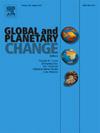罗利浅滩环礁:澳大利亚西北边缘中新世大堡礁的遗迹
IF 4
1区 地球科学
Q1 GEOGRAPHY, PHYSICAL
引用次数: 0
摘要
澳大利亚的热带西北大陆架拥有各种各样的现代珊瑚礁。在18°S以北有6个陆架边缘孤立的环礁,包括:安石礁、斯科特礁和色林加帕坦礁,以及3个罗利浅滩。宁格鲁礁是西北角22°S附近的一个边缘礁。所有这些珊瑚礁都是在晚中新世(~ 10 Ma)淹没的一个巨大的2000公里长的堡礁的遗迹。尽管在该地区进行了广泛的油气勘探,但这些孤立的珊瑚礁的历史并不为人所知。在罗利浅滩附近的国际海洋发现地点U1464进行的地震分析和地层学分析表明,这些现代孤立的环礁在中新世堡礁基础上生存下来的过程中,经历了与气候和构造运动有关的复杂进化。本文章由计算机程序翻译,如有差异,请以英文原文为准。
The Rowley Shoals atolls: Remnants of a Miocene great barrier reef on the north-west Australian margin
The tropical North West Shelf of Australia hosts a diverse range of modern reefs. Six shelf edge isolated atolls are present north of 18°S including: Ashmore Reef, Scott Reef and Seringapatam Reef, and three Rowley Shoals. The Ningaloo Reef is a fringing reef around the North West Cape at 22°S. All of these reefs are the remnants of a vast 2000 km long barrier reef that drowned during the Late Miocene (∼10 Ma). Despite extensive hydrocarbon exploration in the region, the history of these isolated reefs is not well known. Seismic analyses combined with stratigraphic analyses of International Ocean Discovery Site U1464 near the Rowley Shoals has revealed that these modern isolated atolls have a complex evolution related to climate and tectonism as they managed to survive on their Miocene barrier reef foundation.
The first Miocene reefs (∼17 Ma) near the Rowley Shoals were isolated small, mound-shaped features. These evolved into a barrier reef by the Middle Miocene (∼16 Ma). However, by the Late Miocene (∼10 Ma) this barrier reef backstepped landward, evolved into isolated mounds/atolls and drowned prior to the Miocene-Pliocene boundary (∼6 Ma) largely due regional tectonic subsidence. Early Pliocene reef expansion (∼4.6 Ma) led to the growth of four isolated atolls (the Rowley Shoals) related to local faulting and Early Pliocene warmth. Subsequently a second Pliocene reef growth phase occurred from ∼3.5 to 3 Ma when eastern Indian Ocean sea surface temperatures cooled by ∼4 °C due to Indonesian Gateway constriction and a reduced Leeuwin Current. By the Pleistocene (∼2.4 Ma) one the four Rowley Shoals had drowned. Strong sea level variability, together with Indonesian Throughflow constriction and reduction in intensity of the Leeuwin Current after 2.4 Ma may have led to enhanced cooling and regional upwelling. These factors may have been sufficient to cause local drowning of the southerly fourth Rowley Shoal while the more northerly three Shoals survived until present.
求助全文
通过发布文献求助,成功后即可免费获取论文全文。
去求助
来源期刊

Global and Planetary Change
地学天文-地球科学综合
CiteScore
7.40
自引率
10.30%
发文量
226
审稿时长
63 days
期刊介绍:
The objective of the journal Global and Planetary Change is to provide a multi-disciplinary overview of the processes taking place in the Earth System and involved in planetary change over time. The journal focuses on records of the past and current state of the earth system, and future scenarios , and their link to global environmental change. Regional or process-oriented studies are welcome if they discuss global implications. Topics include, but are not limited to, changes in the dynamics and composition of the atmosphere, oceans and cryosphere, as well as climate change, sea level variation, observations/modelling of Earth processes from deep to (near-)surface and their coupling, global ecology, biogeography and the resilience/thresholds in ecosystems.
Key criteria for the consideration of manuscripts are (a) the relevance for the global scientific community and/or (b) the wider implications for global scale problems, preferably combined with (c) having a significance beyond a single discipline. A clear focus on key processes associated with planetary scale change is strongly encouraged.
Manuscripts can be submitted as either research contributions or as a review article. Every effort should be made towards the presentation of research outcomes in an understandable way for a broad readership.
 求助内容:
求助内容: 应助结果提醒方式:
应助结果提醒方式:


